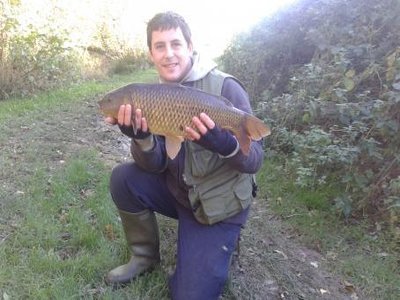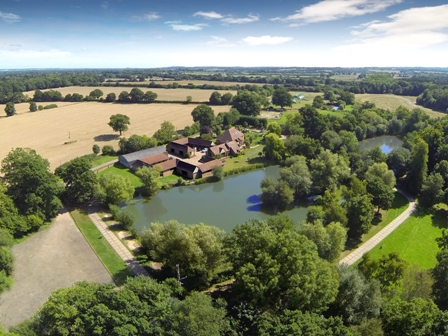Not being a typical still-water fisherman but totally committed to rebuilding my derelict farm I needed some form of relaxation that I could pursue without having to spend valuable time setting up and clearing away.
Fly fishing fitted the bill and so I decided to turn Lake One into a trout lake. Dave Gaskin of Country Pursuits ran the water for me and although my motivation wasn’t money I did not want to lose out on the deal either! Not only did the water lose money under the management of Dave but I found the type of angler it attracted to be quite obnoxious. Needless to say it was soon shut down.
Before the trout lake was stocked it had to be dredged of the silt and debris of centuries. It started life as a duck flight pond whereby the farmer could step out of his house and bag a duck or two for dinner. Maintenance of the flight pond was not something a farmer would have had time for so leaves and various drainage systems filled the lake. It took two months for the dredging and a further six months to landscape thanks to a 30 tonne Volvo dump truck and a 360 excavator.
My brother in law, Colin Tubb, an ardent carp angler and also my farm manager, suggested that I turn the lake into a day ticket water for coarse fishing. There were already thirty or forty large carp in the waters and Pondwood was one of the most prolific breeding waters around for that species. (It was shallow and warmed-up very quickly)
Lake one soon got a reputation for good size carp and the complex started to make a profit – excluding, of course, the tens of thousands of pounds spent on dredging etc. Lake two was prolific and known to host as many as three spawns a year. Many fish dealers purchased fry to bring on and sell to other fisheries.

Changes in the fish farming industry slowed sales of carp fry as breeders were now using artificial methods; this caused lake two to overstock with no predation whatsoever. Six catfish were introduced to Lake One and the fry from both lakes were used to feed them, eradicating the fry by using them as bio mass. The catfish grew and bred as prolifically as the carp but with a difference: the catfish also used their own fry for sustenance. Lake One became quite famous with anglers from all over the UK and even from mainland Europe wanting to hook a catfish, and Lake Two had become well known as a family lake that guaranteed a catch by anyone with a rod and line; not just one or two fish but dozens regardless of experience.
Over the years no less than four other local fisheries opened and catfish were introduced to two of those waters while the other two concentrated on carp and native species. One had to keep in front by making changes as well as upgrading and increasing the stock. In all honesty I feel that the other catfish waters have not quite captured the magic of Pondwood. Keeping catfish is not that easy as they need a vast amount of biomass to sustain their feeding habits. Fry are important not only for other species to feed on, but if fish are breeding it is important that they also feed on their own species in order to maintain the balance.
Snake Water was constructed from a ditch of around a metre wide and one kilometre in length. Its form was naturally snake-like hence the name. A series of small ponds were now linked by the increased width of around 16 metres – perfect for a match pole.

The match fishing aspect of the Snake was fantastic for around 8 to 10 years but then other waters took on the match challenge. In any case, the carp had grown too large for the match angler! Some anglers had paid thousands for their poles and a 25lb + carp was no longer a welcome catch. The match angler, although being excited about hooking such a fish, would rather hook and land fish up to around 5lbs as this was a quick capture and on to the next.
The fourth water on the Pondwood complex, Woodland Lake, started life as a swamp. In 2010 the swamp was dredged and excavated to become what it is today. It was stocked with smaller fish from Lake Two (up to 5lbs) and was to be the new match water. There was quite a bit of excitement from the local match anglers with many wanting to be the first to fish it.
In January 2011 the first match took place with sixteen anglers and a top weight of 133lbs followed by two bags in the 90s and a lowest weight of 42lbs. In less than two weeks word had got around and the diary filled not only for 2011 but for 2012 too.
This autumn has seen yet another series of changes at Pondwood with major works and alterations to the Snake, Lake One and Lake Two. Woodland Lake will have changes in the spring and The Snake will benefit from further improvements allowing localised car parking and alternating bank use. Many changes will be made over the coming months; hopefully they will give little or no inconvenience to anglers while work is in progress.
One of the most welcome changes made in 2015 was the introduction of night fishing. This is allowed throughout the year. Prior to this, night fishing was permitted on alternate Saturdays only and anglers sometimes booked-up 6 months in advance in order to get a swim! Even then the banks were packed and on one night 176 catfish were caught by 24 anglers. Many liked the camaraderie and often fished in groups of five or six, barbeques and takeaways being the norm.
The record of 176 catfish in one night has not been broken and I doubt if it ever will.
Well that’s it for now. Maybe I’ll see you on the bank!










